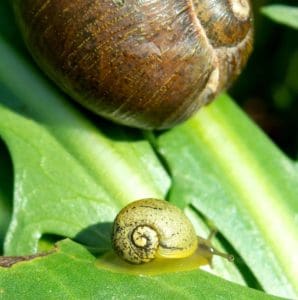
A juvenile green snail beside an adult. Image – Anna N. Chapman, CC0, via Wikimedia Commons, ex-PIRSA.
A SMALL green snail has slowed the movement of urgently needed Western Australian hay into South Australia, but fodder expert Tim Ford believes defining national demand is a bigger issue.
Sheep and Grain Central have confirmed that WA hay has been blocked from travelling east, due to quarantine restrictions to prevent introducing the green snail (Cornu apertus, is also known as Cantareus apertus).
However, Sheep Central was told PIRSA and Livestock SA are working on a solution that will allow the importation of hay into SA from some areas of Western Australia.
The Department of Primary Industries and Regions South Australia website said the snail has been established in the Perth metropolitan area since the 1980s and in September 2011, it was detected near Cobram in northern Victoria. Importing green snail host materials into South Australia is restricted from all of Western Australia and Cobram, PIRSA said.
PIRSA’s website said the snails are proficient hitchhikers and move between regions on farm machinery and vehicles that carry infested host materials. The snail is native to southern Europe and North Africa.
Mature green snails have an olive-green shell and white flesh. They are between the smaller vineyard snail and white Italian snail, and the larger common garden snail, in size. Green snails rarely exceeds 25 mm in shell diameter.
One Western Australian farmer said the SA quarantine conditions had also prevented WA hay from getting to the flood-affected parts of New South Wales. He said the green snail was not in all areas of WA.
“It’s a bit bloody ridiculous.”
Feed Central chief executive officer Tim Ford said he was aware WA hay imports into South Australia had stopped.
“There is no hay coming in from Western Australia (into SA); it needs a quarantine protocol (for the Green snail) that really can’t be achieved.
“There has been no volume of hay move from the west to the east,” he said.
“There has been talk of it, but from what I know very very small quantities have moved from Western Australia and it’s currently stopped.”
Mr Ford said eastern Australian could handle thousands of tonnes of hay from Western Australia, but sourcing WA supplies was only part of the solution to satisfying national demand.
He said the current quarantine requirement to steam heat hay from WA before entering SA is not possible to achieve.
To enter SA, WA hay must either be steam-treated to kill snails or baited and inspected, and then stored safely and securely covered to prevent any spillage during transit. It requires a Plant Health Certificate or Plant Health Assurance Certificate and commercial operators importing hay from WA must be registered as importers with PIRSA. All commercial consignments must be inspected on arrival by either a business registered with PIRSA or PIRSA biosecurity officers if being brought in for commercial purposes.
“Surely we can work with government to get another way to fumigate or achieve the same outcome.
“I don’t want to bring snails in from the west if this snail is a real problem, but surely we can work together to get the same outcome.”
Mr Ford said the WA hay import issue is an example of the necessity for federal and state governments to work with industry to meet the logistical challenge of meeting national livestock fodder demand.
He said Feed Central is creating a dedicated ‘expressions of interest’ webpage where hay buyers could fill out a survey to list their fodder needs and generate demand volume data that could be collated anonymously to inform government of the national hay requirements.
“So the governments and industry could see the volume of hay that is needed.”
Hay supply issues continued for flood-affected NSW farmers
Fraser’s Hay at Dubbo is a major supplier to dairy farms on the north coast of NSW, and is working hard to keep deliveries up to clients hit by this month’s floods, many of whom have lost their infrastructure as well as fodder.
In recent months, the business has also been supplying southern graziers who have run out of their own fodder, or are unable to source it locally.
“I’ve been in this game for 50 years, and hay’s as scarce as I’ve seen it,” Ron Fraser said.
“I’ve never seen it run out completely; what people will do is go to second-grade varieties, or corn stubble, or sorghum stubble; it will all work into the ration, and there’s plenty of grain about.”
Mr Fraser said the company’s demand arc has recently swung as far south as Victoria, and into the Monaro district of south-east NSW.
“We’re putting a lot into Victoria, and into southern NSW, around Wagga and Holbrook.
“It’s only been in the past couple of months that a lot started moving down there.”
Mr Fraser said the current situation was a flip of what happened because of the 2018-20 drought, when hay from Vic, SA, and even the Northern Territory was sourced to feed NSW and Qld livestock.
“If feels a little bit strange, coming up empty, and everything is in reverse,” he said from the cab on his northward journey home from a hay delivery to Lockhart in the Riverina.
Mr Fraser said inquiry from South Australia was filtering in, and some loads were going out towards Broken Hill, normally supplied by hay merchants closer to Adelaide, as graziers looked for hay to feed in the yards ahead of stock being trucked north.
“In SA, they’re weighing up the freight factor, and I’m finding a lot of people are not going down the feeding path; they’re sending stock up into Queensland instead on agistment.
“All my mates with stock crates are running up there with load after load.”
On the bright side, Mr Fraser said the Riverina has greened up considerably with pasture and germinating crops after good rain in the past week or so.
PIRSA and Livestock SA was contacted for comment.

There is only a small section near the Perth metropolitan area that has green snails. The threat from WA is less than the threat from Victoria. Most of Victoria is open to trade between SA with basically no checkpoints on that border.
CommodityAG has tried to donate hay to SA and been declined from doing so by the SA Government twice now.
WA is best positioned to help the Eyre Peninsula farmers and this is a real shame the government won’t help their farmers by relaxing the fundamentally flawed quarantine they have in place.
Good day. I am concerned that hay production has been slowed down by the snail issue. What rice farmers are doing in the Philippines is practical use of ducks. Chemicals were used, but it did less. Other farmers who raised ducks and then sold eggs made another business. They rent out hundreds of ducks to rice farmers where snails are infesting their rice fields. The ducks made a miracle. The ducks can easily consume the snail eggs and the snails big and small. The ducks are transported in early morning then taken back in the afternoon. Duck farmers can save on duck foods while earning on duck eggs and renting out the ducks. It has helped a lot. Just sharing this idea. I wish it can help Australia and your farmers. By the way, Filipinos eat Balut duck eggs, a very nutritious food. Please try it. Thank you.